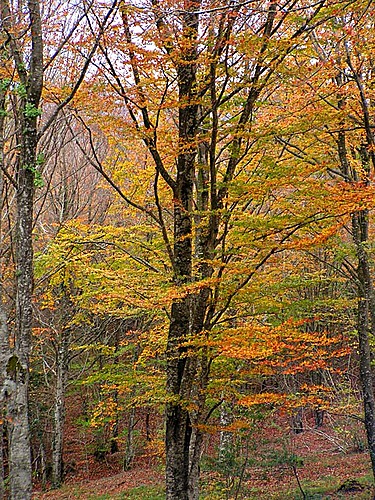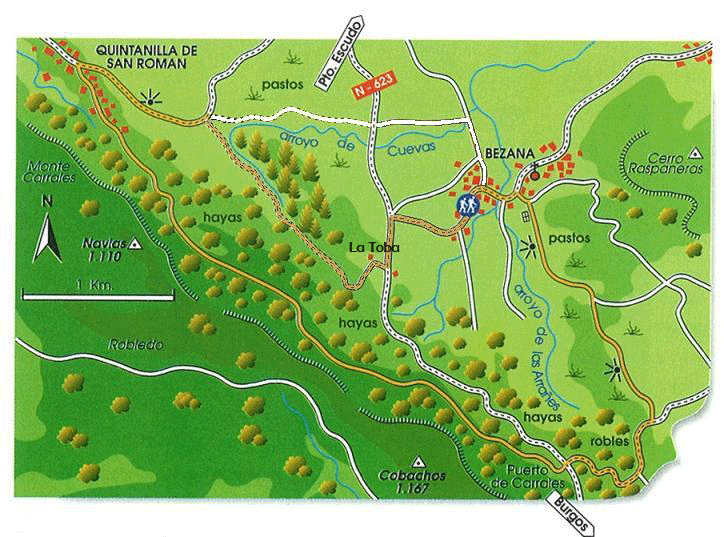BEECH FOREST OF CARRALES

In the extreme northwest of the province, right on the border between Valdebezana Valley and neighboring Cantabria, is located one of the most beautiful, extensive and best preserved deciduous forests of all Burgos: the beech forest of Carrales. The magical atmosphere and the cool shade that is breathed inside a forest of beech trees invite to a quiet walk that in this case, given the scarce difficulty of the terrain, is recommended for all types of walkers. A journey through the beech forest of Carrales can be the best way to initiate the little ones in contact and love for nature.
We propose a route to know this magnificent environment. From the rural house La Toba we went to the town of Bezana. In the center of this town you have to look for the concrete path that after passing a lane with a lathe leads to the cemetery of the same.
Bezana is a town that in addition to giving name to the Valdebezana Valley preserves some samples of the typical popular construction of the area: the mountain stone house with sun lounge or balcony on the upper floor.
A certain Cantabrian air
After passing by the walls of the Bezana cemetery, the road continues its march through an area of meadows where the two animals that make up the economic base of the inhabitants of the region graze: cows and horses. The landscape based on small pastures is the result of a secular livestock activity that little by little has been gaining ground to a deciduous forest that in its day would cover almost the entire territory of Valdebezana. The frequent mists, an evergreen landscape and the grazing cattle quietly evoke in the walker an image very similar to that of the juicy valleys of the neighboring Cantabria.
When arriving at a crossroads it is necessary to follow the path on the right and take a decisive step towards the search for Carrales forest.
Precisely from this clear path you can enjoy magnificent views of the whole forest. The dimensions of the beech forest of Carrales are remarkable and make it appear as one of the most important indigenous hardwood forests of the province of Burgos. It is a forest about ten kilometers long by one and a half wide and develops on the gentle slope of Monte de Carrales. At present the forest begins on the 900 meters of altitude and ascends until the same summit of the Cobachos, Navias and Pico Nava.
The province of Burgos, due to its privileged geographical location, is one of the few peninsular territories that can boast of sharing the two biogeographical regions that span the Iberian Peninsula: the Mediterranean region, dry Spain, and the Eurosiberian or Atlantic region, the Wet Spain. If the first covers almost the entire provincial territory, the second is confined to the northernmost end of it. Precisely the area that corresponds to the Valdebezana Valley belongs to this humid Iberia, which, as its name indicates, is characterized by its abundant rainfall and the absence of summer drought. These climatic factors greatly influence the vegetal landscape that in this area of Burgos is dominated by the forest of hardwoods: depending on the soil, the orientation and the altitude the oaks and beeches alternate and distribute the potential climaxes.
Green Cathedrals
Without any problem the road reaches the paved road that connects the Santander road with the towns of Torres de Arriba and Torres de Abajo. To continue the route, take the paved path to the right. Very soon the presence of the autochthonous forest is evident. Large specimens of sessile oak and carballo oak alternate with a thick understory in which hazel trees, birches, holly, maples and ash trees intermingle. When they gain height, the first beech trees make their appearance. From now on the beech will be the omnipresent species in the forest.
The beech (Fagus sylvatica) is a robust and at the same time slender tree that can reach a height of up to 40 meters. Its crown is oval or rounded and its trunk is usually straight with smooth bark of ashen or whitish color. It presents numerous horizontal or ascending branches and a dense foliage that projects a thick shadow. The leaves are oval with very marked lateral nerves. Light green they turn dark with the passage of time. Before falling, during the autumn, they acquire a beautiful and contrasted bronze tone.
After a small climb the narrow road leads to the national road. Just opposite the crossroads and on the other side of it there is the old road that goes into the heart of the beech forest. The beauty of the shadow beech groves is unique and unforgettable. The walker will be enveloped in a quiet silence, interrupted only by the delicate song of the birds, and in the peculiar and humid atmosphere that reigns inside forests that without any exaggeration can be considered true green cathedrals.
Living in the shade.
The smoothness of the route allows you to fully enjoy the sensory pleasure of the forest. With a little attention it will not be difficult to discover the presence of some of its numerous inhabitants. Among the mammals stand out, badgers, wild cats, roe deer, wild boars and wolves. Between the birds it emphasizes the black pito, a species that at provincial level practically only can be located within these beech forests of Valdebezana Valley.
Suddenly the road begins to descend and without paying attention to any crossroads it reaches the well preserved – still good standing copies of the typical mountain house – farmhouse of Quintanilla de San Román. After crossing the village, you have to take the road that to the right leads to the nearby Cilleruelo de Bezana. In less than a kilometer, at the height of the first curve of the road, the road is located that also to the right and after saving a hatch for the cattle heads towards the rural house The Toba. Crossing a new area of grassland very soon we reach a closed porthole, which we will open and leave closed again, so that the cattle that are in the pastures do not leave. Us
We found the house.

Carrales beech forest route
Recommended time: Spring, summer and autumn.
Difficulty: Low.
Distance and time: 11 kilómetros and three hours.
Interest: Native forests, fauna and architecture
popular.
